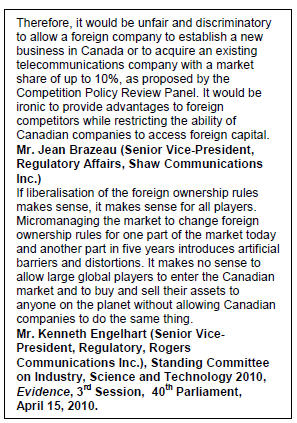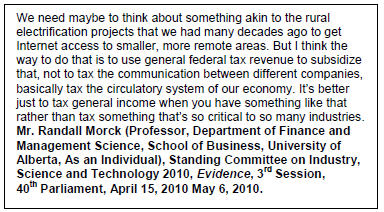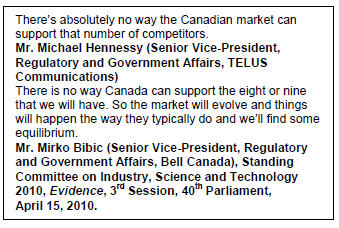Based on the economic narrative examined in Chapter 2, the
arguments in favour of removing foreign ownership restrictions appear
compelling. Indeed, to the extent that removing foreign restrictions could help
increase competitive pressure in the wireless market, and potentially improve
some of the market features, such a change in policy would likely be beneficial
to the economic welfare of Canadians. This is the economic case. However, there
are also important social and equity dimensions to the foreign ownership
question. This section examines the elements related to those aspects.
Public Mobile, a new entrant in the wireless market that appeared
before the Committee, suggested that the extremely low level of cellular mobile
penetration is indicative of the fact that the large incumbents are not
interested in servicing markets that are considered less lucrative (rural,
low-density, or lower-income individuals). Public Mobile has made no secret
that it is going after the markets that are underserved by the large incumbents:
Public Mobile, unlike some of the other new
entrants, is actually not competing head to head with some of the incumbents.
We aren’t going upmarket. We aren’t offering BlackBerrys and smart phones. We’re
actually aimed directly at what we refer to as “the unserved market”. We’re
going after the working-class Canadians who require predictability in their
bill. If you did the research and really looked into why working-class Canadians,
that one third of Canadians, don’t have cell phones, it’s because they’re
value-conscious. They live paycheque to paycheque.
The Committee does not have any evidence to substantiate the claim
that the large incumbents are more interested in going after the high-end
market segments, but notes that the low level of cellular mobile penetration in
Canada relative to other countries does indicate that a large swath of the
Canadian population is not using wireless phones at this time. Of course,
reasons for this underutilisation could be multi-fold. For example, since
wireline and wireless are sometimes considered substitutes, a reasonably priced
and well served wire line market would act as a deterrent to an increase in
cellular phone penetration. A poor wire line infrastructure has in fact been an
important catalyst to increasing cellular phone penetration in some countries.
Moreover, cultural differences could play a role in the lower Canadian
utilisation levels as well. Nonetheless, the difference is so important in
mobile cellular penetration between the Canadian market and other OECD markets
that the Committee is of the view that pricing in the Canadian wireless market
segment must be playing a role to some extent. In particular, the two studies
surveyed in Chapter 2 would suggest that Canada is not a low-price country in
terms of mobile phone service.
Consequently, some portion of the Canadian population may decide
not to own a wireless phone because of pricing concerns. This creates an
“equity” issue whereby “working class” Canadians could be priced out of the
market. As relayed to the Committee by Alek Krstajic, CEO of Public Mobile,
this constitutes an argument against maintaining the status quo on foreign
ownership rules to the extent that the current rules do not favour an increase
in competitive pressure in the wireless market, which could lead to a decrease
in consumer prices and an increase in market penetration.
Officials from Industry Canada indicated to the Committee that the
removal of foreign ownership restrictions is under consideration for telecommunications
industries only, not for broadcasting industries. Since broadcasting
distribution undertakings (BDU) are regulated under the Broadcasting Act,
a number of witnesses (e.g., MTS Allstream, Shaw, Rogers, Bell, Telus) that are
integrated market players (i.e., that are both telecommunications common
carriers and BDUs) informed the Committee that they strongly oppose the
potential differential treatment of telecommunications carriers and
broadcasting distributors with respect to the liberalisation of foreign
ownership rules. They indicated that technological convergence has resulted in
corporate convergence, and that creating an artificial difference between the
two types of businesses from a regulatory standpoint would put them at a
competitive disadvantage.
Before the advent of the Internet age, telecommunications carriage
and broadcasting distribution were clearly separate undertakings from a
technological and corporate standpoint; one was dealing with phone service, the
other with television. Technological convergence has changed this reality. In
the broadcasting distribution segment, firms that used to be strictly
considered phone companies (e.g., Bell) are now going after the market share of
what used to be the sole preserve of established BDUs (e.g., Rogers, Shaw, and
Videotron). Conversely, these established BDUs are now trying to take a share
of the home phone market away from the traditional phone companies. Both types
of businesses are competing head to head in the Internet broadband market segment.
In the wireless segment, two of the dominant players (Bell and Telus) have
their origins in the traditional wireline phone segment and one (Rogers) has
its roots in the traditional broadcasting distribution segment. Given this
reality, it could be argued that the integrated players (Bell, Telus, Rogers,
Videotron, Shaw, MTS Allstream) are direct competitors in the fixed phone, Internet
broadband and cable distribution segments. Moreover, as a result of the latest
spectrum auction, two new entrants in the wireless market are from the
traditional broadcasting distribution segment (Videotron and Shaw). Therefore,
wireless telephony constitutes an additional market segment where major
integrated players will compete against each other.
In this context, it is not surprising to see why these integrated
players (Telus, Rogers, Shaw and MTS Allstream) are in favour of removing the
ownership restrictions if applied equally to both telecommunications common
carriers and BDUs. If foreign ownership restrictions are removed under the Telecommunications
Act only, it would expose the integrated players (i.e., those that are both
telecommunications common carriers and BDUs) to the competitive threat of
non-integrated players (pure-play telecommunication common carriers) that would
have unlimited access to foreign capital.
This competitive threat would perhaps force the integrated players
to spin off their telecommunications carriage businesses (i.e., create separate
telecommunications carriage subsidiaries) in order to make them eligible to
receive unlimited foreign capital investment. Such changes could, however,
affect their “integrated offerings” (whereby television, Internet, phone
services are bundled in a single package) since phone and Internet services
would now be offered by different subsidiaries. Therefore, removing foreign
ownerships restrictions for telecommunications common carriers only could be
considered inequitable from the integrated players’ perspective.
It should be noted that the Telecommunications Review Panel was
acutely aware of this issue in its 2006 report. Although it recommended partial
removal of foreign ownership restrictions starting with the telecommunications
carriage segment as a first step, it also recommended that the federal government
undertake a complete review as to how these changes could apply to BDUs without
affecting broadcasting content.
Both
the 2006 Telecommunications Review Panel and the 2008 Competition Policy Review
Panel proposed a phased-in approach to the removal of foreign ownership
restrictions. In the first phase, the federal cabinet would be granted
authority to waive foreign ownership restrictions for telecommunications common
carriers when a foreign investment is deemed in the public interest. According
to both panels, a presumption would be made that foreign investments in any
start-up telecommunications common carrier or one with less than 10 % of
the total revenues generated in any telecommunications service are in the
public interest. The second phase, which would take place only after a complete
review of broadcasting policy, would consist of greater liberalisation of
foreign investment rules to players of all sizes and would extend this
liberalisation to broadcasting distribution undertakings (but not to
broadcasters). Large established market players that appeared before the
Committee typically opposed a phased–in approach on the ground that it provides
an unfair competitive advantage to smaller players or new entrants.
 Telecommunications
carriage and broadcasting distribution cannot be considered in the same manner
as a plant producing goods; moving all equipment into another country to take
advantage of lower costs is not an option. From this perspective, foreign
ownership could appear to be less of a threat to employment levels than is the
case in other industries. However, witnesses on both sides of the foreign
ownership debate indicated that a decrease in head office jobs (including
research and development) in Canada could result from the removal of foreign
ownership restrictions. To use a specific example, if Verizon Corporation, a
major U.S. telecommunications company, were to acquire the telecommunications
carriage and broadcasting distribution activities of Bell Canada, this would
likely result in a decrease in the number of head office jobs in Canada. Professor
Globerman of Western Washington University offered a dissenting view on this
issue. He suggested that global value chains are making location a very
fungible item in the elaboration of corporate strategy and that companies are
moving activities to where it’s efficient to do those activities. In this
light, according to the Professor, it could be the case that by saying no to
foreigners, Canada is denying itself the opportunity to do more research and
development.
Telecommunications
carriage and broadcasting distribution cannot be considered in the same manner
as a plant producing goods; moving all equipment into another country to take
advantage of lower costs is not an option. From this perspective, foreign
ownership could appear to be less of a threat to employment levels than is the
case in other industries. However, witnesses on both sides of the foreign
ownership debate indicated that a decrease in head office jobs (including
research and development) in Canada could result from the removal of foreign
ownership restrictions. To use a specific example, if Verizon Corporation, a
major U.S. telecommunications company, were to acquire the telecommunications
carriage and broadcasting distribution activities of Bell Canada, this would
likely result in a decrease in the number of head office jobs in Canada. Professor
Globerman of Western Washington University offered a dissenting view on this
issue. He suggested that global value chains are making location a very
fungible item in the elaboration of corporate strategy and that companies are
moving activities to where it’s efficient to do those activities. In this
light, according to the Professor, it could be the case that by saying no to
foreigners, Canada is denying itself the opportunity to do more research and
development.
Notwithstanding this last argument, loss of head office employment
is a possible undesirable by-product of removing foreign ownership
restrictions. This undesirable impact has to be weighed against the possible
advantages of this policy change described earlier.
It was made clear to the Committee that the first stop on the road
to more competition in the wireless segment lies in urban areas. Given higher
population density, urban areas are much more profitable than rural areas for
telecommunications common carriers. New independent players in the wireless
segment (e.g., Public Mobile and Globalive) made no secret that they intend to
target urban areas first. They further pointed out that as urban markets become
saturated, competition would naturally move to rural areas. According to them,
rural areas will eventually reap the benefits of allowing foreign ownership,
but with a time lag relative to urban areas. Incumbent wireless operator Rogers
Communications made reference to the approach of their new competitors:
Globalive isn’t going to do anything for the rural
areas. They are honest about the fact that they are going to only provide
service in the major urban areas. None of the new entrants will go to the rural
areas. We’re already doing a huge amount. This revolution in wireless broadband
is something that I would urge this committee to take note of.
The equity issue embodied by the rural-urban divide would perhaps
not be a major problem if removal of foreign ownership restrictions led to
increased competition and lower prices in urban areas while also benefiting—or
at least not harming—consumers in rural and remote areas. A scenario where
prices in rural areas increase as a result of increasing competition in urban
centers cannot, however, be completely ruled out. Cross-subsidising between
profitable and non-profitable business segments is a well known practice in the
telecommunications industry. This raises the spectre of cut-throat competition
in urban centres leading to higher prices in rural and remote areas through
geographical cross-subsidisation practices from major market players in the
wireless segment.
 Some
witnesses who appeared before the Committee pointed out that the best way to
deal with urban-rural divide issues is through a government direct subsidy
program (funded from general revenues). This last option is the one that is
typically favoured by economists since it is considered the least market
distorting and the most efficient. This option was also recommended by the 2006
Telecommunications Review Panel to fund broadband expansion in areas that are
considered less profitable to commercial operators.
Some
witnesses who appeared before the Committee pointed out that the best way to
deal with urban-rural divide issues is through a government direct subsidy
program (funded from general revenues). This last option is the one that is
typically favoured by economists since it is considered the least market
distorting and the most efficient. This option was also recommended by the 2006
Telecommunications Review Panel to fund broadband expansion in areas that are
considered less profitable to commercial operators.
Also mentioned in the urban-rural divide debate is the fact that
the goal of a business, whether Canadian or foreign-owned, is ultimately to
maximise profit, not to achieve a given societal objective. From this
perspective, there is not much difference between a Canadian telecommunications
company and a foreign-owned one; neither will invest in a project for the sole
purpose of providing services to rural and remote areas if the project is not
commercially viable. Only government policy could ensure that such investments
are undertaken.
 As
shown in Chapter 2, most OECD countries have three wireless operators that hold
the vast majority of the domestic market share. From this perspective, Canada’s
situation is not much different than that in other countries. Witnesses
indicated that in the long run, the Canadian market cannot possibly sustain
eight or nine players in the wireless segment. Therefore, by removing foreign
ownership restrictions, Canada could run the risk of having the worst of both
worlds: end up with the same number of operators as is the case currently (or
even a lower number) and have those few operators be foreign-owned. In such a
scenario, the increase in the level of competition resulting from the removal
of foreign ownership restrictions could be a temporary phenomenon tantamount to
a “hit-and-run”, with operating margins and prices being driven down in the
short-term by the increase in the number of operators and
the removal of foreign ownership restrictions. This would ultimately encourage
consolidation through buy-outs or bankruptcies of the weaker elements. The end
picture could be an increase in market concentration, a lower level of
competition and perhaps even higher prices.
As
shown in Chapter 2, most OECD countries have three wireless operators that hold
the vast majority of the domestic market share. From this perspective, Canada’s
situation is not much different than that in other countries. Witnesses
indicated that in the long run, the Canadian market cannot possibly sustain
eight or nine players in the wireless segment. Therefore, by removing foreign
ownership restrictions, Canada could run the risk of having the worst of both
worlds: end up with the same number of operators as is the case currently (or
even a lower number) and have those few operators be foreign-owned. In such a
scenario, the increase in the level of competition resulting from the removal
of foreign ownership restrictions could be a temporary phenomenon tantamount to
a “hit-and-run”, with operating margins and prices being driven down in the
short-term by the increase in the number of operators and
the removal of foreign ownership restrictions. This would ultimately encourage
consolidation through buy-outs or bankruptcies of the weaker elements. The end
picture could be an increase in market concentration, a lower level of
competition and perhaps even higher prices.
Professor Globerman from Western Washington University indicated
that it should be precisely the role of the Competition Bureau to protect and
promote competitive markets and prevent this scenario from happening. In
contrast, Peter Murdoch (from Media, Communications, Energy and Paperworkers
Union of Canada) took issue with relying on the on the Competition Bureau:
[Y]ou heard that Canada’s
Competition Act will prevent large foreign companies from buying up
Canadian telecommunications firms and acquiring market dominance. But even
domestically this legislation has not worked well. It certainly has not stopped
Canada’s cable systems from buying up their competitors so that five companies
now set the prices for 90% of all cable subscribers in Canada.